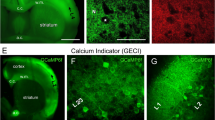Abstract
Methods to record action potential (AP) firing in many individual neurons are essential to unravel the function of complex neuronal circuits in the brain. A promising approach is bolus loading of Ca2+ indicators combined with multiphoton microscopy. Currently, however, this technique lacks cell-type specificity, has low temporal resolution and cannot resolve complex temporal firing patterns. Here we present simple solutions to these problems. We identified neuron types by colocalizing Ca2+ signals of a red-fluorescing indicator with genetically encoded markers. We reconstructed firing rate changes from Ca2+ signals by temporal deconvolution. This technique is efficient, dramatically enhances temporal resolution, facilitates data interpretation and permits analysis of odor-response patterns across thousands of neurons in the zebrafish olfactory bulb. Hence, temporally deconvolved Ca2+ imaging (TDCa imaging) resolves limitations of current optical recording techniques and is likely to be widely applicable because of its simplicity, robustness and generic principle.
This is a preview of subscription content, access via your institution
Access options
Subscribe to this journal
Receive 12 print issues and online access
$259.00 per year
only $21.58 per issue
Buy this article
- Purchase on Springer Link
- Instant access to full article PDF
Prices may be subject to local taxes which are calculated during checkout





Similar content being viewed by others
References
Grinvald, A., Frostig, R.D., Lieke, E. & Hildesheim, R. Optical imaging of neuronal activity. Physiol. Rev. 68, 1285–1366 (1988).
Zochowski, M. et al. Imaging membrane potential with voltage-sensitive dyes. Biol. Bull. 198, 1–21 (2000).
Logothetis, N.K. & Pfeuffer, J. On the nature of the BOLD fMRI contrast mechanism. Magn. Reson. Imaging 22, 1517–1531 (2004).
Denk, W., Strickler, J.H. & Webb, W.W. Two-photon laser scanning fluorescence microscopy. Science 248, 73–76 (1990).
Helmchen, F. & Denk, W. Deep tissue two-photon microscopy. Nat Methods 2, 932–940 (2005).
Stosiek, C., Garaschuk, O., Holthoff, K. & Konnerth, A. In vivo two-photon calcium imaging of neuronal networks. Proc. Natl. Acad. Sci. USA 100, 7319–7324 (2003).
Brustein, E., Marandi, N., Kovalchuk, Y., Drapeau, P. & Konnerth, A. “In vivo” monitoring of neuronal network activity in zebrafish by two-photon Ca2+ imaging. Pflugers Arch. 446, 766–773 (2003).
Ohki, K., Chung, S., Ch'ng, Y.H., Kara, P. & Reid, R.C. Functional imaging with cellular resolution reveals precise micro-architecture in visual cortex. Nature 433, 597–603 (2005).
Li, J. et al. Early development of functional spatial maps in the zebrafish olfactory bulb. J. Neurosci. 25, 5784–5795 (2005).
Sullivan, M.R., Nimmerjahn, A., Sarkisov, D.V., Helmchen, F. & Wang, S.S. In vivo calcium imaging of circuit activity in cerebellar cortex. J. Neurophysiol. 94, 1636–1644 (2005).
Kerr, J.N., Greenberg, D. & Helmchen, F. Imaging input and output of neocortical networks in vivo. Proc. Natl Acad. Sci. USA 102, 14063–14068 (2005).
Helmchen, F., Imoto, K. & Sakmann, B. Ca2+ buffering and action potential-evoked Ca2+ signaling in dendrites of pyramidal neurons. Biophys. J. 70, 1069–1081 (1996).
Laurent, G. Olfactory network dynamics and the coding of multidimensional signals. Nat. Rev. Neurosci. 3, 884–895 (2002).
Shipley, M.T. & Ennis, M. Functional organization of olfactory system. J. Neurobiol. 30, 123–176 (1996).
Zerucha, T. et al. A highly conserved enhancer in the Dlx5/Dlx6 intergenic region is the site of cross-regulatory interactions between Dlx genes in the embryonic forebrain. J. Neurosci. 20, 709–721 (2000).
Higashijima, S., Masino, M.A., Mandel, G. & Fetcho, J.R. Imaging neuronal activity during zebrafish behavior with a genetically encoded calcium indicator. J. Neurophysiol. 90, 3986–3997 (2003).
Friedrich, R.W. & Laurent, G. Dynamic optimization of odor representations in the olfactory bulb by slow temporal patterning of mitral cell activity. Science 291, 889–894 (2001).
Pinault, D. A novel single-cell staining procedure performed in vivo under electrophysiological control: morpho-functional features of juxtacellularly labeled thalamic cells and other central neurons with biocytin or Neurobiotin. J. Neurosci. Methods 65, 113–136 (1996).
Friedrich, R.W. & Korsching, S.I. Combinatorial and chemotopic odorant coding in the zebrafish olfactory bulb visualized by optical imaging. Neuron 18, 737–752 (1997).
Friedrich, R.W. & Laurent, G. Dynamics of olfactory bulb input and output activity during odor stimulation in zebrafish. J. Neurophysiol. 91, 2658–2669 (2004).
Friedrich, R.W., Habermann, C.J. & Laurent, G. Multiplexing using synchrony in the zebrafish olfactory bulb. Nat. Neurosci. 7, 862–871 (2004).
Miesenbock, G. & Kevrekidis, I.G. Optical imaging and control of genetically designated neurons in functioning circuits. Annu. Rev. Neurosci. 28, 533–563 (2005).
MacLean, J.N., Watson, B.O., Aaron, G.B. & Yuste, R. Internal dynamics determine the cortical response to thalamic stimulation. Neuron 48, 811–823 (2005).
Kay, L.M. & Laurent, G. Odor- and context-dependent modulation of mitral cell activity in behaving rats. Nat. Neurosci. 2, 1003–1009 (1999).
Chafee, M.V. & Goldman-Rakic, P.S. Matching patterns of activity in primate prefrontal area 8a and parietal area 7ip neurons during a spatial working memory task. J. Neurophysiol. 79, 2919–2940 (1998).
Steriade, M., Timofeev, I. & Grenier, F. Natural waking and sleep states: a view from inside neocortical neurons. J. Neurophysiol. 85, 1969–1985 (2001).
Wilson, R.I., Turner, G.C. & Laurent, G. Transformation of olfactory representations in the Drosophila antennal lobe. Science 303, 366–370 (2004).
Singer, W. Neuronal synchrony: a versatile code for the definition of relations? Neuron 24, 49–65 (1999).
Wang, J.W., Wong, A.M., Flores, J., Vosshall, L.B. & Axel, R. Two-photon calcium imaging reveals an odor-evoked map of activity in the fly brain. Cell 112, 271–282 (2003).
Sachse, S. & Galizia, C.G. The coding of odour-intensity in the honeybee antennal lobe: local computation optimizes odour representation. Eur. J. Neurosci. 18, 2119–2132 (2003).
Acknowledgements
We thank W. Denk, T. Euler, J. Kerr, G. Laurent, H. Riecke, P.H. Seeburg and members of the Friedrich laboratory for support, helpful discussions, and/or comments on the manuscript. This work was supported by the Max Planck-Society, the Deutsche Forschungsgemeinschaft (DFG; SFB 488), and a fellowship from the Boehringer Ingelheim Fonds to E.Y.
Author information
Authors and Affiliations
Corresponding author
Ethics declarations
Competing interests
The authors declare no competing financial interests.
Supplementary information
Supplementary Fig. 1
Principle of firing rate reconstruction by temporal deconvolution. (PDF 145 kb)
Supplementary Fig. 2
Decay time constants and their influence on deconvolution. (PDF 273 kb)
Supplementary Fig. 3
Iterative smooting procedure. (PDF 111 kb)
Supplementary Fig. 4
Deconvolution parameter search results. (PDF 83 kb)
Supplementary Fig. 5
Comparison of temporal deconvolution to other methods. (PDF 156 kb)
Rights and permissions
About this article
Cite this article
Yaksi, E., Friedrich, R. Reconstruction of firing rate changes across neuronal populations by temporally deconvolved Ca2+ imaging. Nat Methods 3, 377–383 (2006). https://doi.org/10.1038/nmeth874
Received:
Accepted:
Published:
Issue Date:
DOI: https://doi.org/10.1038/nmeth874
This article is cited by
-
Multimodal in vivo recording using transparent graphene microelectrodes illuminates spatiotemporal seizure dynamics at the microscale
Communications Biology (2021)
-
Acitretin reverses early functional network degradation in a mouse model of familial Alzheimer’s disease
Scientific Reports (2021)
-
A database and deep learning toolbox for noise-optimized, generalized spike inference from calcium imaging
Nature Neuroscience (2021)
-
Stimulus-specific behavioral responses of zebrafish to a large range of odors exhibit individual variability
BMC Biology (2020)
-
Whitening of odor representations by the wiring diagram of the olfactory bulb
Nature Neuroscience (2020)



